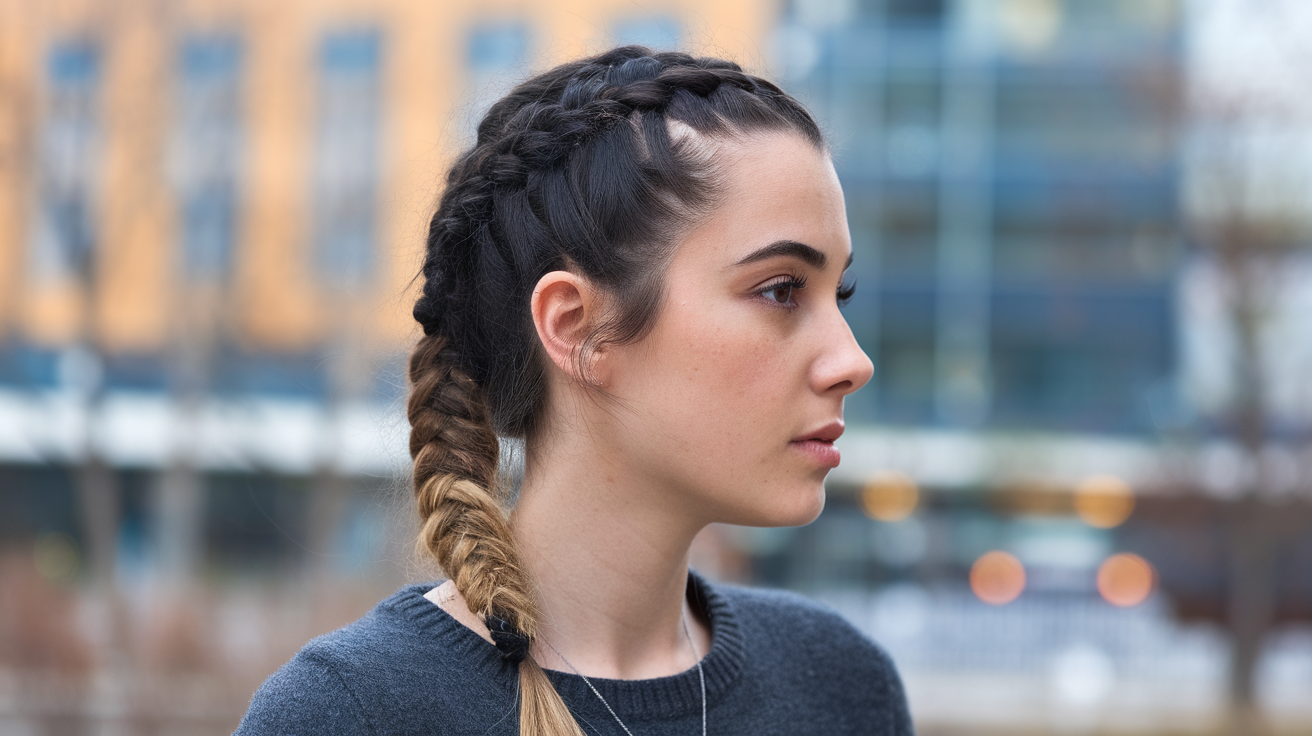Dutch braids have long been a favorite hairstyle for women seeking a chic and practical look. These inverted French braids, woven close to the scalp, offer a sleek appearance and stay put throughout the day. Now, a new trend is taking this classic style to the next level: Dutch braids with extensions.
Adding extensions to Dutch braids opens up a world of possibilities. This combination allows women to achieve fuller, longer braids without waiting for their natural hair to grow. Extensions also provide the opportunity to play with different colors and textures, creating eye-catching styles that stand out from the crowd.
The following sections will guide you through the process of creating stunning Dutch braids with extensions. We’ll cover everything from preparing your hair and choosing the right extensions to step-by-step braiding techniques and maintenance tips. Get ready to discover how this reinvented style can transform your look and boost your confidence.
- What makes Dutch braids with extensions so appealing?
- How do you prepare for Dutch braids with extensions?
- What's the step-by-step process for Dutch braiding with extensions?
- Which Dutch braid styles can you create with extensions?
- How do you maintain Dutch braids with extensions?
- Elevate Your Style with Dutch Braids and Extensions
- Frequently Asked Questions
What makes Dutch braids with extensions so appealing?

Dutch braids with extensions have become increasingly popular among women seeking a fresh and glamorous hairstyle. This combination offers a range of benefits that make it stand out from traditional braiding techniques.
Enhanced volume and length
One of the main draws of adding extensions to Dutch braids is the instant boost in volume and length. You can achieve a fuller, more luxurious look without waiting months or years for your natural hair to grow. This is particularly appealing if you have fine or thin hair, as the extensions can give your braids a thicker, more substantial appearance.
But why stop at just adding length? Extensions also allow you to create intricate styles that might be challenging with shorter hair. Imagine crafting elaborate updos or long, flowing braids that cascade down your back – all possible with the right extensions.
Versatility in styling options
The versatility of Dutch braids with extensions is truly remarkable. You can create a wide array of styles to suit different occasions and moods. Some popular options include:
- Double Dutch braids for a sporty look
- A single side braid for an elegant touch
- Crown braids for a romantic, bohemian vibe
- Half-up, half-down styles for a casual yet chic appearance
This flexibility means you can switch up your look without committing to a permanent change. Whether you’re heading to the office, attending a wedding, or going for a workout, there’s a Dutch braid style with extensions that fits the bill.
Longer-lasting braids
Another advantage of incorporating extensions into your Dutch braids is their longevity. Traditional braids can become loose or frizzy after a day or two, but adding extensions can help your style stay intact for longer. The extra weight and structure provided by the extensions help maintain the braid’s shape and neatness.
This durability is especially beneficial for busy women who don’t have time for daily styling. You can enjoy your braided look for several days without significant touch-ups, saving you precious time in your morning routine.
Ability to experiment with colors
Have you ever wanted to try a bold hair color but hesitated due to the commitment or potential damage? Dutch braids with extensions offer a perfect solution. You can easily incorporate colorful extensions into your braids for a temporary pop of color or a subtle ombre effect.
This technique allows you to play with different shades without the need for harsh chemicals or permanent dyes. It’s an excellent way to express your creativity and add a fun twist to your look, all while keeping your natural hair healthy.
Protection for natural hair
Surprisingly, Dutch braids with extensions can actually help protect your natural hair. By incorporating extensions, you reduce the strain on your own locks during the braiding process. This can be particularly beneficial for women with fine or fragile hair.
Additionally, this style can serve as a protective measure against environmental factors. Your natural hair is tucked away in the braids, shielded from sun exposure, wind, and other elements that can cause damage or dryness.
To maximize the protective benefits, consider these tips:
- Use high-quality, gentle extensions that won’t cause friction
- Avoid braiding too tightly to prevent stress on your scalp and hairline
- Moisturize your natural hair before braiding to keep it hydrated
- Take breaks between braided styles to allow your hair and scalp to rest
Dutch braids with extensions offer a winning combination of style and practicality. They provide the opportunity to achieve stunning looks while also caring for your natural hair. Whether you’re looking for a dramatic change or a subtle enhancement, this versatile technique has something to offer every woman.
How do you prepare for Dutch braids with extensions?

Preparing for Dutch braids with extensions requires careful planning and attention to detail. The right preparation can make a significant difference in the final look and longevity of your hairstyle. Let’s explore the essential steps to get you ready for stunning Dutch braids with extensions.
Choosing the right extensions
Selecting the appropriate extensions is crucial for achieving a natural and seamless look. Consider the texture, color, and length of your natural hair when making your choice. Synthetic extensions are budget-friendly but may not blend as well with your hair. Human hair extensions, while pricier, offer a more natural appearance and can be styled with heat tools.
What about the attachment method? Clip-in extensions are popular for their ease of use and versatility. However, tape-in or sew-in extensions might be better suited for long-term wear. Whichever type you choose, make sure the color matches your natural hair or creates the desired contrast if you’re going for a bold look.
Washing and conditioning your hair
Clean, well-nourished hair provides the best foundation for Dutch braids with extensions. Start by washing your hair with a sulfate-free shampoo to avoid stripping natural oils. Follow up with a hydrating conditioner, focusing on the mid-lengths and ends of your hair.
Should you use a deep conditioning treatment? Absolutely! This extra step can help soften your hair and make it more manageable for braiding. Apply a deep conditioner or hair mask once a week, leaving it on for 15-30 minutes before rinsing.
Brushing and detangling
Properly detangled hair is essential for smooth, neat braids. Begin by using a wide-tooth comb to gently work out any knots, starting from the ends and working your way up to the roots. This technique helps prevent breakage and minimizes hair loss during the detangling process.
Once you’ve removed the major tangles, switch to a boar bristle brush or a detangling brush to smooth out your hair completely. Take your time with this step – rushing through it can lead to frizz and uneven braids later on.
Applying hair oil or serum
A small amount of hair oil or serum can work wonders in preparing your hair for Dutch braids with extensions. These products help to:
- Tame flyaways and frizz
- Add shine to your hair
- Provide extra slip for easier braiding
- Protect your hair from potential damage during the braiding process
Apply a few drops of your chosen product to your palms and distribute it evenly through your hair, focusing on the mid-lengths and ends. Be careful not to use too much, as this can make your hair greasy and cause the braids to slip.
Sectioning your hair
The final step in preparing for Dutch braids with extensions is sectioning your hair. This process helps create clean, even braids and makes it easier to incorporate the extensions seamlessly.
How should you section your hair? The exact method will depend on the style you’re aiming for, but here’s a general guide:
- Part your hair down the middle from forehead to nape.
- Divide each half into three or four smaller sections.
- Secure each section with a small hair tie or clip.
If you’re planning on a single braid or an asymmetrical style, adjust your sectioning accordingly. The key is to create manageable portions that will make the braiding process smoother and more organized.
By following these preparation steps, you’ll set yourself up for success with your Dutch braids and extensions. Taking the time to properly prepare your hair will result in a more polished, long-lasting style that you’ll be proud to show off.
Remember, practice makes perfect. Don’t be discouraged if your first attempt isn’t flawless – with each try, you’ll improve your technique and discover what works best for your hair type and desired style.
What’s the step-by-step process for Dutch braiding with extensions?

Creating Dutch braids with extensions might seem challenging at first, but with practice, you’ll master this stylish technique. The process involves several key steps, each contributing to the final polished look.
Clipping in the extensions
Begin by sectioning your hair horizontally, starting at the nape of your neck. Take your first weft of extensions and open the clips. Gently tease the roots of your natural hair where you’ll attach the extensions. This creates a secure base for the clips to grip onto. Now, snap the clips shut, ensuring they’re firmly attached to your hair.
Work your way up your head, adding more wefts as you go. How many should you use? That depends on the thickness of your natural hair and the desired fullness of your braids. Generally, 3-4 wefts per side are sufficient for most styles.
Starting the Dutch braid technique
With your extensions in place, it’s time to start braiding. Dutch braids are essentially inside-out French braids. You’ll be crossing sections under rather than over each other.
Begin at your hairline, taking a small section of hair and dividing it into three equal parts. Cross the right strand under the middle, then the left strand under the new middle. As you continue, incorporate more hair from the sides into each section before crossing it under.
Why start with small sections? This creates a neater, more defined braid at the hairline. As you move down your head, you can gradually incorporate larger sections of hair.
Incorporating extensions into the braid
As you braid, you’ll naturally come across the wefts of extensions. Don’t panic! Simply treat them as part of your natural hair. Incorporate the extension hair into the appropriate section of your braid, just as you would with your own hair.
A common question is: “How do I keep the extensions from showing?” The key is to blend them seamlessly. As you braid, make sure to include both your natural hair and the extension hair in each section. This creates a uniform look throughout the braid.
Maintaining tension and neatness
Consistent tension is crucial for a polished Dutch braid. As you work, keep a firm grip on the hair sections. However, be careful not to pull too tightly, especially near your hairline, as this can cause discomfort and potential damage to your hair.
To maintain neatness:
- Use a fine-toothed comb to smooth out each section before incorporating it into the braid
- Keep your fingers close to your scalp as you braid to prevent loose strands
- Periodically check your work in a mirror to ensure the braid is straight and even
If you notice any bumps or unevenness, don’t be afraid to undo a few crosses and rebraid that section. It’s better to take your time and get it right than to rush and end up with a messy result.
Securing the braid end
As you reach the end of your braid, you might notice the extensions extending beyond your natural hair length. This is normal! Continue braiding until you’ve incorporated all the hair, including the extensions.
To secure the end, use a small, clear elastic band. Wrap it tightly around the end of the braid to prevent unraveling. For a more polished look, you can take a small section of hair from the end of the braid and wrap it around the elastic, tucking the end underneath and securing it with a bobby pin.
Some women prefer to add a decorative element at this point, such as a ribbon or a cute hair accessory. This can be a fun way to personalize your style and add a pop of color or sparkle.
Remember, creating perfect Dutch braids with extensions takes practice. Don’t get discouraged if your first attempts aren’t flawless. With each try, you’ll improve your technique and develop a feel for working with the extensions.
A final tip: after completing your braid, gently tug at the edges to loosen it slightly. This creates a softer, more relaxed look and can make your braid appear fuller. It also helps to disguise any slight imperfections in your braiding technique.
By following these steps and practicing regularly, you’ll soon be creating stunning Dutch braids with extensions that turn heads and boost your confidence.
Which Dutch braid styles can you create with extensions?

Dutch braids with extensions offer a world of styling possibilities. From casual everyday looks to elegant updos for special occasions, these versatile braids can be adapted to suit various preferences and hair types.
Double Dutch braids (pigtails)
This classic style, also known as boxer braids, features two parallel Dutch braids running from the forehead to the nape of the neck. It’s a popular choice for sports and active lifestyles due to its secure and long-lasting nature.
To create this look, part your hair down the middle and clip one side away. Start Dutch braiding on the unclipped side, incorporating the extensions as you go. Repeat on the other side. For a more relaxed vibe, gently tug at the edges of the braids to loosen them slightly.
Dutch braid crown
A Dutch braid crown creates a regal, romantic look that’s perfect for weddings, proms, or any special event. This style involves braiding around the head, creating a crown-like effect.
Begin by parting your hair to one side. Start Dutch braiding from the part, following your hairline and incorporating extensions as you go. Continue braiding around your head, tucking the end of the braid underneath and securing it with bobby pins. Finish by pulling out a few face-framing tendrils for a softer look.
How can you add extra glamour to this style? Consider weaving small flowers or decorative pins into the braid for a truly enchanting effect.
Half-up Dutch braid
The half-up Dutch braid combines the best of both worlds – the intricacy of a braid and the flowing beauty of loose hair. This style works well for various occasions, from casual outings to formal events.
To achieve this look, section off the top portion of your hair. Dutch braid this section back, incorporating extensions for added volume and length. Secure the braid with an elastic band. You can leave the rest of your hair loose or style it with waves or curls for added texture.
Want to spice up this style? Try these variations:
- Create two parallel half-up Dutch braids instead of one
- Add a fishtail braid to the loose portion of hair
- Incorporate colorful extensions for a fun pop of color
Dutch braid ponytail
A Dutch braid ponytail elevates the classic ponytail, adding sophistication and intrigue. This style is versatile enough for both work and play.
Start by Dutch braiding from your hairline towards the back of your head. Once you reach the crown, gather all your hair (including the braid) into a ponytail and secure it with an elastic band. For a polished finish, wrap a small section of hair around the elastic to conceal it.
Side-swept Dutch braid
The side-swept Dutch braid is a romantic, slightly asymmetrical style that’s perfect for those who want to show off their facial features. It’s an excellent choice for date nights or red carpet events.
Begin by parting your hair deeply to one side. Start Dutch braiding from the fuller side of the part, working your way down and across the nape of your neck. Continue braiding until you reach the opposite shoulder, then secure the end with an elastic band.
This style looks particularly striking when you incorporate ombre or balayage extensions, creating a beautiful color gradient throughout the braid.
Each of these styles offers its own charm and can be customized to suit your personal taste. Don’t be afraid to mix and match elements from different styles or add your own creative touches. The key is to experiment and find what works best for you and your hair.
Remember, practice makes perfect. If a style doesn’t turn out exactly as you hoped the first time, keep trying. With each attempt, you’ll improve your technique and develop a better understanding of how to work with your hair and extensions.
Lastly, consider the occasion and your outfit when choosing a Dutch braid style. A sleek Dutch braid ponytail might be perfect for a business meeting, while a romantic Dutch braid crown could be ideal for a summer wedding. By matching your hairstyle to the event and your overall look, you’ll exude confidence and style wherever you go.
How do you maintain Dutch braids with extensions?
Maintaining Dutch braids with extensions is crucial for prolonging the life of your hairstyle and keeping it looking fresh. With proper care, you can enjoy your braids for an extended period while protecting both your natural hair and the extensions.
Protecting your braids while sleeping
Nighttime care plays a significant role in preserving your Dutch braids. To prevent tangling and frizz, wrap your braids in a silk or satin scarf before going to bed. This reduces friction between your hair and the pillowcase, helping to maintain the neat appearance of your braids.
Another option is to use a silk or satin pillowcase. These smooth fabrics minimize hair breakage and help retain moisture in your hair and extensions. Some women prefer to gently twist their braids into a loose bun on top of their head, securing it with a soft scrunchie before sleeping.
Refreshing the style
Over time, your Dutch braids may start to look a bit worn. Refreshing them can bring back their original allure. Here are some quick tips to revitalize your style:
- Apply a light leave-in conditioner to add moisture
- Use a small amount of hair oil to tame frizz and add shine
- Gently re-braid any loose sections
- Smooth down flyaways with a soft-bristled brush
For a more thorough refresh, you might consider visiting your stylist. They can tighten the braids and touch up any areas that have become loose or frizzy.
Managing frizz and flyaways
Frizz and flyaways are common issues with braided styles, especially in humid weather. To combat this, keep a small bottle of anti-frizz serum or hair oil in your bag for on-the-go touch-ups. Apply a small amount to your hands and gently smooth it over the surface of your braids.
A toothbrush can be a handy tool for taming stubborn flyaways. Spray a little hairspray on the toothbrush and use it to smooth down any stray hairs along your hairline or part.
Proper removal of extensions
When it’s time to take out your Dutch braids, patience is key. Rushing the process can lead to damage to both your natural hair and the extensions. Start by gently unraveling the braids, working from the bottom up. If you encounter any knots, use your fingers or a wide-toothed comb to carefully detangle them.
Once the braids are undone, remove the extensions one by one. Be careful not to pull on your natural hair in the process. If you’re having difficulty, a bit of leave-in conditioner can help loosen any tangles.
After removing all the extensions, give your natural hair a thorough but gentle wash. Use a clarifying shampoo to remove any product buildup, followed by a deep conditioning treatment to restore moisture.
Cleaning and storing extensions
Proper care of your extensions can extend their lifespan, saving you money in the long run. After removing the extensions, gently wash them in lukewarm water with a mild shampoo. Rinse thoroughly and apply a light conditioner, focusing on the ends.
Allow the extensions to air dry completely before storing them. Never store damp extensions, as this can lead to mold growth. Once dry, gently brush the extensions and store them in a cool, dry place. A dedicated storage bag or box can help protect them from dust and tangling.
If you use synthetic extensions, be cautious with heat styling tools, as excessive heat can damage the fibers. For human hair extensions, you can use heat tools, but always apply a heat protectant first.
Regular maintenance of your Dutch braids with extensions not only keeps your style looking fresh but also protects your natural hair. By following these care tips, you can enjoy your braided style for longer periods while maintaining the health of your hair.
Remember that everyone’s hair is different, so you may need to adjust these maintenance techniques to suit your specific needs. Pay attention to how your hair and extensions respond to different products and methods, and don’t hesitate to consult with your stylist if you have any concerns.
With proper care and attention, your Dutch braids with extensions can remain a stunning and low-maintenance hairstyle option, allowing you to enjoy the best of both worlds – the intricate beauty of braids and the versatility of added length and volume.
Elevate Your Style with Dutch Braids and Extensions
Dutch braids with extensions offer a world of possibilities for women looking to refresh their hairstyle. From casual double braids to elegant crown styles, this versatile technique allows you to express your creativity and enhance your natural beauty. By mastering the art of Dutch braiding with extensions, you’ll have a go-to style that’s both practical and stunning for any occasion.
Remember that practice and proper maintenance are key to achieving and preserving the perfect Dutch braid look. Take the time to care for your braids and extensions, protecting them while you sleep and refreshing them as needed. With patience and attention to detail, you’ll soon find yourself creating head-turning styles that boost your confidence and showcase your unique personality. So why not give Dutch braids with extensions a try? Your hair journey might just take an exciting new turn.
Frequently Asked Questions
Q: What are Dutch braids?
A: Dutch braids are inverted French braids where you cross sections of hair under rather than over each other, creating a raised braid effect.
Q: Why add extensions to Dutch braids?
A: Extensions add volume, length, and the ability to experiment with different colors and styles without committing to permanent changes.
Q: How do you prepare hair for Dutch braids with extensions?
A: Wash and condition your hair, brush and detangle it, apply a hair oil or serum, and section your hair before starting the braiding process.
Q: What’s the basic technique for Dutch braiding with extensions?
A: Start by dividing a section of hair into three parts, then cross the right strand under the middle, followed by the left strand under the new middle, incorporating more hair and extensions as you go.
Q: How long do Dutch braids with extensions typically last?
A: With proper care, Dutch braids with extensions can last anywhere from 1-2 weeks, depending on your hair type and maintenance routine.
Q: What are some popular Dutch braid styles with extensions?
A: Popular styles include double Dutch braids (pigtails), Dutch braid crown, half-up Dutch braid, Dutch braid ponytail, and side-swept Dutch braid.
Q: How do you protect Dutch braids with extensions while sleeping?
A: Wrap your braids in a silk or satin scarf, use a silk or satin pillowcase, or gently twist your braids into a loose bun secured with a soft scrunchie.
Q: How do you manage frizz and flyaways in Dutch braids with extensions?
A: Use a small amount of anti-frizz serum or hair oil, and tame stubborn flyaways with a toothbrush sprayed with hairspray.
Q: How should you clean and store hair extensions after removing them?
A: Gently wash extensions with mild shampoo, condition them, allow them to air dry completely, then store them in a cool, dry place, preferably in a dedicated storage bag or box.

